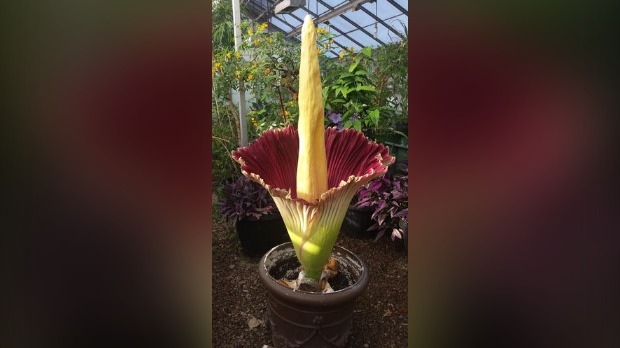'Continuing to smell every year': Guelph man inherits rare corpse flower
A Guelph man received a plant as a family heirloom last month but, when it started to bloom, it was hard to stomach the strong stench.
“The smell is kind of comparable to either a dead animal, rotting milk or rotting meat,” said Andrew Nascimben.
The gift was a plant with the species name Amorphophallus konjac. The konjac has many morbid nicknames like Devil’s tongue, voodoo lily and corpse flower due to its unique, bold colour and structure.
Nascimben’s grandfather took care of the plant for decades before passing it onto him.
“I think he had enough of the smell and my nonna has had enough of the smell,” said Nascimben. “Fifty years later it’s still in the family and continuing to smell every year.”
The exotic plant is native to tropical areas of eastern Asia and is considered rare in Ontario
There are a few konjacs in the greenhouse at McMaster University. Staff said the plants have become somewhat of an attraction, with many people curious to see and smell the flower when it is in bloom, which is when it is at its smelliest.
A biology professor at the university said the reason the plant produces such a foul scent is to attract flies.
“The plant is deliberately making it. It will actually speed up your metabolism in the flowers when it’s shedding pollen and heat up,” Susan Dudley said.
 A corpse flower at McMaster University (Supplied: Susan Dudley)
A corpse flower at McMaster University (Supplied: Susan Dudley)
The corpse flower has also been spotted at the University of Waterloo.
“There’s less than 1,000 of these plans left in the native habitats, so making it even more rare of a plant to have,” said Simon Chuong, a biology professor at UW
The Nascimbens named their flower Nadja. It has now been moved upstairs after being banished to the basement for being too smelly.
 A Guelph man inherited a rare corpse flower (Supplied: Andrew Nascimben)
A Guelph man inherited a rare corpse flower (Supplied: Andrew Nascimben)
“It was down there for about two or three days and then the smell subsided so we brought back it back up to the living room,” Nascimben said.
Nascimben said the plan is to plant it outside in the spring and try to keep it alive for another 50 years or for however long his daughters can stand to be near the pungent plant.
“Keep it in family. Keep the tradition going,” said Nascimben.
CTVNews.ca Top Stories

Canada 'already past due' on NATO defence spending target: U.S. House intelligence committee chair Mike Turner
The chair of the United States House intelligence committee says Canada needs to accelerate its defence spending targets, especially with its military in 'desperate' need of investment.
Scurvy resurgence highlights issues of food insecurity in Canada's rural and remote areas
A disease often thought to only affect 18th century sailors is reemerging in Canada.
Nova Scotia Tories appear safe with close battle for second between Liberals and NDP
With two days left before Nova Scotians elect their next government, polls suggest Progressive Conservative Leader Tim Houston's decision to call an early vote will pay off and the real battle will be between the Liberals and NDP for second place.
Lotto Max jackpot hits $80M for second time ever
The Lotto Max jackpot has climbed to $80 million for just the second time in Canadian lottery history.
Police thought this gnome looked out of place. Then they tested it for drugs
During a recent narcotics investigation, Dutch police said they found a garden gnome made of approximately two kilograms of MDMA.
After Trump's Project 2025 denials, he is tapping its authors and influencers for key roles
After being elected the 47th president on Nov. 5, Donald Trump is stocking his second administration with key players in the Project 2025 movement he temporarily shunned.
Trudeau calls violence in Montreal 'appalling' as NATO protest continues
Anti-NATO protesters gathered again in Montreal on Saturday to demand Canada withdraw from the alliance, a day after a demonstration organized by different groups resulted in arrests, burned cars and shattered windows.
Four convicted in Spain over homophobic murder that sparked nationwide protests
Four men were convicted on Sunday in connection with the homophobic murder of a 24-year-old nursing assistant that sparked nationwide protests.
Cher 'shocked' to discover her legal name when she applied to change it
Cher recalls a curious interlude from her rich and many-chaptered history in her new book 'Cher: The Memoir, Part One.'
































